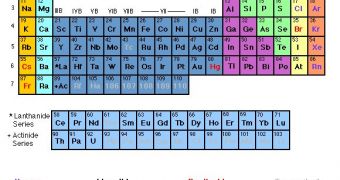The heaviest chemical element known to occur naturally in Earth's crust is uranium 92 while the heaviest chemical element known to exist, a synthetic element, bears the atomic number 118. All elements heavier than uranium are highly unstable and quickly disintegrate into other stable chemical elements - this is why they cannot occur naturally. Nevertheless, physicists have predicted that chemical elements much heavier than uranium can exist in a stable form, in an area of the Periodic Table of Elements called the 'island of stability'.
A team of physicists claim that they have found a possible chemical element bearing the atomic number 122 inside a solution prepared from natural minerals, meaning that it could also exist freely in nature. The problem is that it decays in only a matter of a few fractions of a second. How could such a stable, heavy chemical element exist naturally for such a long time and decay immediately after being detected? This is the question posed by skeptical scientists.
According to the team making the claim, the element was found in a purified solution of thorium 90 during a mass spectrometer investigation. Thorium has an atomic mass of roughly 232. However, the team says mass spectrometer measured a few atoms as having a mass of 292, which is heavier than any element ever discovered. Amnon Marinov from the Hebrew University of Jerusalem, leader of the team that made the discovery, says that they have taken in consideration a possible contamination with hydrocarbon molecules, which could account for the anomaly, although upon verification none were found.
"Every molecule that can be found in the laboratory has slightly lower mass", says Marinov. Thus the reading can only be explained through the presence of an element bearing the atomic number 122, an isotope of this element, or maybe even element 124 in an isotope with 168 neutrons.
Theoretical work shows that such an element would decay in just a few second. Marinov on the other hand believes that if the atom is in a highly excited state it could exist much longer than the theoretical calculations show. This means that it would have to have a half-life larger than 100 million years. Tantalum-180, for example, could exist in a highly excited state as much as a million billion years, thus the possibility is probable, says nuclear physicist Rolf-Dietmar Herzberg from the University of Liverpool.
"There are some gaping holes in the paper", continues Herzberg, who did not participate in the study. One would be that such an element found in a purified Thorium solution should be found through many other natural minerals, albeit since it hasn't yet been detected the possibility is null. "Then it's ludicrous to assume no one has spotted it before", he said. Furthermore, an atom bearing the atomic number 122 in a highly excited state would simply tear itself apart and suffer nuclear fission.
"There are a couple of counts in some mass spectrometer. To claim a new element, you need much better evidence than that. The general interpretation is going to be that there must be a problem with their technique", concluded Kenneth Gregorich from the Lawrence Berkeley Laboratory. Heavier elements have indeed been predicted to be extremely stable, although this 'island of stability' is expected to be found around isotopes with 184 neutrons.

 14 DAY TRIAL //
14 DAY TRIAL //